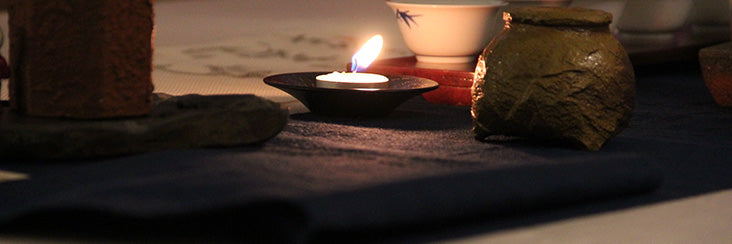
Tea in a Bamboo Theatre
This September, in the heart of Taiwan tea country, the Lu Gu Farmers’ Association’s Living Art of Tea Club held its annual tea gala event. The association rotates its annual tea party from season to season - this year it was held in autumn, just before the national holiday of Mid Autumn Moon Festival. Each year a new theme is chosen that coincides with the season in which it is presented. The title of this year’s event translates as “Tea in a Bamboo Theater” - as it was originally planned to be held outdoors, in a high mountain bamboo forest in the Shan Lin Xi area. However, this proved to be too risky of a prospect due to that fact that we are having a late typhoon season here in Taiwan. Hence, it was held at its traditional venue in the reception hall of the Lu Gu Farmers’ Association.
The tea club designs the decor around the theme of the event, and of course this year it was replete with bamboo, along with giant ferns and other natural adornments selected from nearby mountain forests. There were 20 tables that each accommodated five guests and their host - who personally designed the table display and tea ware. This year, there were three sessions - two on Saturday and one on Sunday. The program was hosted by our close friend and tea mentor, Tony Lin and the new principal of the local junior high school, Patricia Zhu. There was live musical accompaniment performing traditional and modern folk music, along with classical pieces performed on the Chinese hammer dulcimer (yang qin) by a local junior high student who has won national awards. Attendance is by reservation only, and all three sessions were sold out. Admission fee was about US $25 per person.
The event is comprised of two tea brewing sessions, with an intermission where guests are served local delicacy snacks. This break offers the opportunity to socialize and meet new friends. Throughout the first and second sessions, while the stylized, yet relatively informal tea ceremony is enacted in a local Taiwanese style, there is musical performance and poetic commentary to provide atmosphere and entertainment.
This year, the tea served in the first session was an exemplary spring High Mountain Oolong from the highest elevation (2100+m) tea gardens in the Shan Lin Xi region. It was a wonderfully delicate, yet full bodied, fresh and fragrant tea that filled one’s head with a flowery herbal bouquet that lingered long after the tea disappeared. As the tea was served, our hosts explained why this selection was chosen and the character it embodied - leading into poetry and song to accentuate the experience of this exquisite brew. The atmosphere was relaxed, yet ceremonious enough to make it meaningful and even moving.
The second session was particularly special in that this year's first place winner of the spring tea competition at the Lu Gu Farmers' Association was served. This tea competition is the largest and most prestigious Oolong Tea competition in the world, and the champion tea sells for more than US$ 8,000 per pound! But prizes and prices aside, this brew had such character that even the mere recollection of it raises goosebumps. The aroma exuding from the first brew was rich and complex in a way that no singular reference of a scent or flavor was possible. It was at once freshly cut oak and baked winter squash and pine needles and dried apricots...the senses reeled. The tea was amazingly balanced and full flavored - again without easily distinguished attributes or qualities due to its smooth, integrated overall character. It was a true delight.
We have grown to be very fond of these tea parties put on by the Living Art of Tea Club - especially over the last several years. They have matured into a style of tea culture that expresses the purity of nature and refinement of humility. The people are real and friendly as well as skilled and knowledgeable. And the tea is without fail, very impressive and consistently surprises us with its exquisite quality.
We were present at the inaugural event produced by the Living Art of Tea Club in the winter of 1995, and have continued to grow in our appreciation and understanding of the intent and expression that it has embodied. We are deeply grateful for this association that has welcomed us into Taiwanese Tea Culture as we know it in the 21st century.
 |
 |


